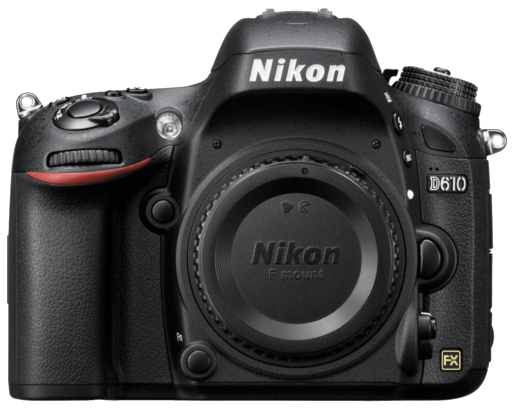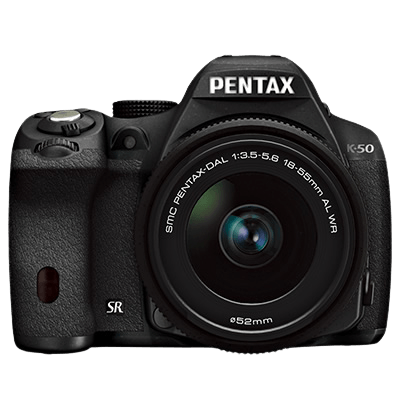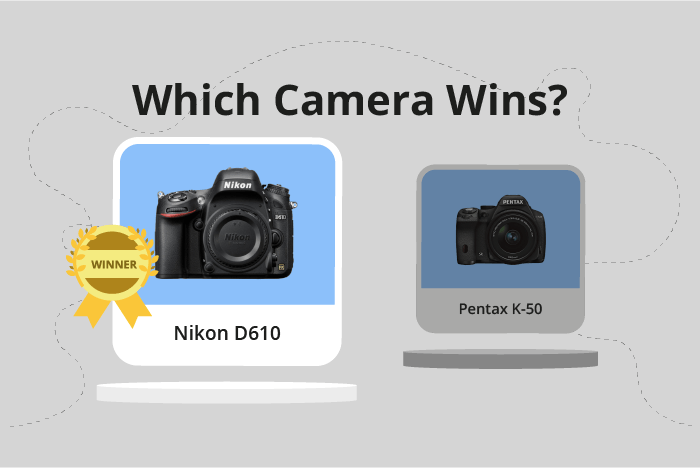Nikon D610 vs Pentax K-50 Comparison
Nikon D610

Pentax K-50

The Nikon D610 emerges as the winner with a score of 66/100, outperforming the Pentax K-50, which scored 57/100. Both cameras are DSLRs released in 2013, with the D610 announced on October 8th and the K-50 on June 12th. They share similarities in their camera type and release year.
The Nikon D610 excels with a higher score, larger size (141 x 113 x 82mm), and heavier weight (850g). Its launch price of $1,999 reflects its superior quality. On the other hand, the Pentax K-50 is more affordable with a launch price of $599, making it a budget-friendly option. Its smaller size (130 x 97 x 71mm) and lighter weight (650g) offer increased portability.
Weighing the advantages of each camera, the Nikon D610 provides better performance, while the Pentax K-50 is a more budget-conscious and portable choice.
Nikon D610 vs Pentax K-50 Overview and Optics
The Nikon D610 outperforms the Pentax K-50 in optics with a score of 70/100 compared to the K-50’s 62/100. Both cameras share some common specifications, such as a CMOS sensor, a shooting speed of 6 frames per second, and a compatible lens mount for their respective brands.
The Nikon D610’s superiority in optics is due to its higher megapixel count of 24, a full-frame sensor size, and a DXOMARK sensor score of 94. These features enable the D610 to capture higher resolution images with better dynamic range and low light performance. The camera’s Expeed 3 processor also contributes to its faster image processing capabilities.
On the other hand, the Pentax K-50 has a lower megapixel count of 16.28 and an APS-C sensor size, which results in a DXOMARK sensor score of 79. However, the K-50 does offer image stabilization, a feature missing in the D610. This advantage allows the K-50 to capture sharper images in certain situations, such as handheld shooting or when using longer focal lengths.
In terms of optics, the Nikon D610 is the clear winner due to its higher resolution, better sensor performance, and larger sensor size. These factors contribute to its higher score of 70/100. The Pentax K-50, while scoring lower at 62/100, still has its merits with the inclusion of image stabilization. Ultimately, the choice between these two cameras will depend on an individual’s specific needs and preferences.
Nikon D610 vs Pentax K-50 Video Performance
The Nikon D610 and the Pentax K-50 both have a video score of 57/100, making them equal in this aspect. Both cameras share common specifications, including Full HD video resolution, maximum video dimensions of 1920 x 1080, a maximum video frame rate of 30fps, and built-in time-lapse functionality.
The Nikon D610 does not outperform the Pentax K-50 in video capabilities, as their specifications and scores are the same. Similarly, the Pentax K-50 does not surpass the Nikon D610 in this area. Both cameras offer satisfactory video performance with their shared features.
Since neither camera has a clear advantage in video capabilities, potential buyers should consider other factors when choosing between the Nikon D610 and the Pentax K-50. While both cameras are capable of producing quality videos, there may be other aspects that are more important to individual users, such as price, size, weight, or additional features.
Given that the video capabilities of the Nikon D610 and the Pentax K-50 are equal, potential buyers should base their decision on other factors. Both cameras are reliable options for producing Full HD videos with a 30fps frame rate and time-lapse functionality.
Nikon D610 vs Pentax K-50 Features and Benefits
The Nikon D610 triumphs over the Pentax K-50 with a feature score of 57/100 as opposed to the K-50’s 54/100. Both cameras share several specifications, including a screen resolution of 921,000 dots, no touchscreen, no flip screen, and no GPS. However, there are key differences that set these two cameras apart.
The Nikon D610 excels with its larger 3.2-inch screen size, providing a better display and user experience compared to the Pentax K-50’s 3-inch screen. Additionally, the D610 is equipped with WIFI capabilities, allowing for seamless photo transfer and remote camera control. This feature is absent in the Pentax K-50, which limits its connectivity options.
The Pentax K-50, despite its lower score, does hold an advantage in terms of simplicity. With no WIFI or Bluetooth, the K-50 is a straightforward camera for users who prefer a more basic experience without the need for additional connectivity features. This can be appealing to some photographers who value simplicity over advanced features.
Taking these points into consideration, the Nikon D610 stands out as the better choice for photographers seeking a larger screen and WIFI connectivity. The Pentax K-50, on the other hand, may be suitable for those who appreciate a more basic camera without the added complexity of wireless features. Each camera caters to different preferences, and the choice ultimately depends on the individual’s specific needs and desired features.
Nikon D610 vs Pentax K-50 Storage and Battery
The Nikon D610 surpasses the Pentax K-50 in storage and battery capabilities with a score of 71/100, a noticeable 47-point difference from the K-50’s score of 24/100. Both cameras share common specifications, such as compatibility with SD, SDHC, and SDXC memory cards, and lacking USB charging capability.
The Nikon D610 excels with its two memory card slots, doubling storage capacity compared to the Pentax K-50’s single slot. Furthermore, the D610’s battery life of 900 shots significantly outlasts the K-50’s 410 shots, making it more suitable for extended photography sessions.
In contrast, the Pentax K-50 does not offer any advantages in storage and battery aspects over the Nikon D610.
Considering these points, the Nikon D610 is the clear winner in terms of storage and battery performance, providing photographers with increased storage capacity and longer battery life.
Nikon D610 vs Pentax K-50 – Our Verdict
Are you still undecided about which camera is right for you? Have a look at these popular comparisons that feature the Nikon D610 or the Pentax K-50:

